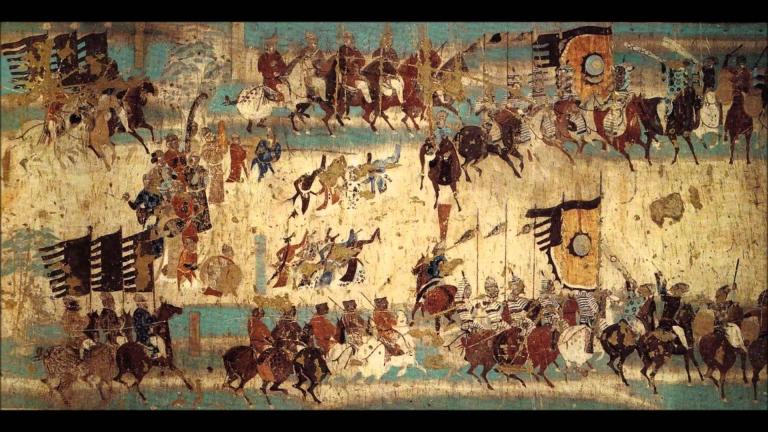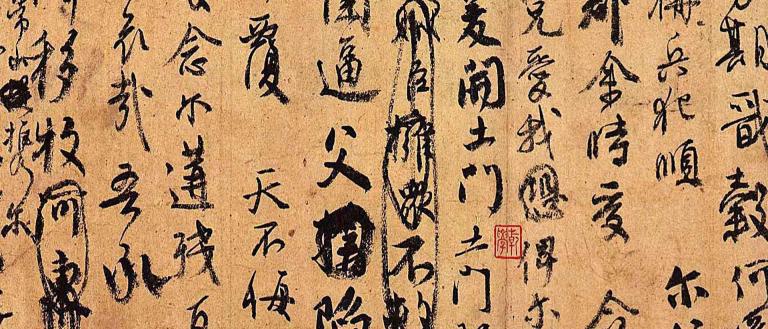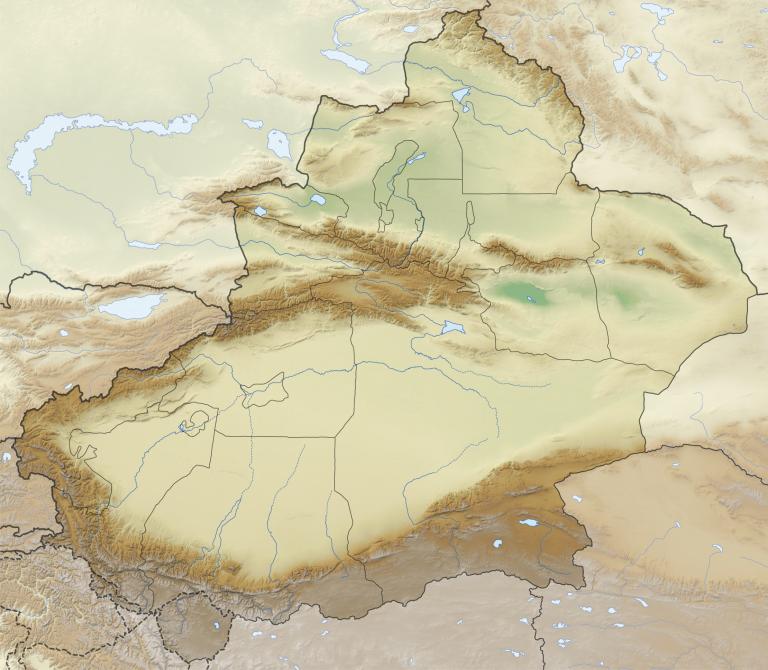Beiting Protectorate
8 min readAs a key national relics protection unit, Beiting Protectorate was the specia administrative institution in the Western Regions established by the tang Dynasty(618-907), whose ruins was located in Beiting Town over 10km to the north of Jimsar County in Xinjiang, also named”Pochengzi Beiting in history was a place of strategic importance in the Western region which once”covered an area as far as beyond Caspian Sea and built a grand cause with powerful army. During the 2,000 years’ history, Beiting was successively occupied by multiple nationalities such as Sairen, Cheshi, Sogdian, Rouran, Turk, Uighur and Mongolian From Later Cheshi Kingdom establishe by the central government of the Western Han Dynasty in 59 BC, Beiting Protectorate, and this ancient city experienced the glory of the Song(960-1279 and Yuan(1271-1368) which was the political and economic center in Xinjiang and the important hub of the new northern path of the silk road Beiting, an important place in the Western Regions.

The history of Beijing can be traced back to the Spring and Autumn and Warring States Period(770 BC-221 BC). According to the records, the 6 Mt Tianshan kingdoms of Sairen were settled here at that time. In the early days of the Western Han Dynasty(206 BC-25 AD), Beiting became the imperial palace of later Cheshi Kingdom, thus it was called Later palace. In the second ear of the shenjue reign of the emperor han Xuan(60 bo), after the government of the Western Regions established Xiyu Protectorate, they set Jinman City here.
The ancient city of beiting first emerged in the Western turk period of the Northern and Southern Dynasties(420-589 ). The famous commercia nationality in history -Sogdian used camels to cross the Central Plains, Xinjiang and the Indo-European Regions and built their own commodity distributioncenter in this place. The turks called it”Kehanfutu City”, which was the rudiment of the ancient city of Beiting.
In the 12 year of the Zhenguan Reign of the Tang Dynasty(638), the Western Turk was divided into 2 khanates including Yipiduolu khan, with his tent in the north and Yipishaboluo Khan, with his tent in the south, which was called as”Beiting”and”Nanting”respectively, thus it was the origin of the name of Beiting. In the 14 year of the Zhenguan Reign(640), the Tang Dynasty set Bechbalig to rule over three counties, including Jinman, Pulei and Luntai Latter the name of jinman County was changed into routing country.
In 702, in order to enhance the governance of the Western Regions, Empress Wu Zetian established Beiting Protectorate (latter promoted to GreatProtectorate) in Beiting and stationed Hanhai army to govern the vast area to the north of Mt Tianshan and Balkhash Lake, including the farthest that time was crowded with people and economically prosperous as the at urisdictional limits as far as the east of caspian sea beiting ancient city important traffic hub and military pass on the Silk road. The position of Beiting Protectorate equaled to the current Urumqi and the official rank ofYang He, the first great Protector, was up to the sub-second rank, which is equal to the current vice-premier rank. this was the most glorious period of Beiting Since then the walls of beijing were repaired and extended and enjoyed a prestigious history in all dynasties for its grand scale.
The former city of Beiting was 1, 500m long from north to south, about 1000m wide from east to west 4,590m in circumference and divided into three tiers. The second tier was 600m long from north to south and 400m wide from east to west. Each side of the third tier was 200m respectively. The thickness of the outer wall was 7-10m, built with tamped earth the thickness of the inner varied within 3-5m with the height about 7m inner and outer cities were built with southern, northern and western gates which connected with each other, and among which, the northern gate was regarded as the main entrance. Protectorate government office was established in the inner ci the second tier as Market street and the outer city stationed with hanhai army and some citizens. there were natural river courses on the east and west of the city, about 200m wide, which combined into one to the west of the northern gate to form a lake in the shape of a crescent where people rowed boats. there vere thick willow and flowers beside the lake to present marvelous sceneries Inside of Beiting, there were many buildings, plants and temples. the people were good at metallurgy and jade sculpture, thus all industries thrived Among which the animal husbandry was particularly developed with more rare horses which were grazed by their hair color. the people are rich andpeaceful, so even the poor people also took meat as their staple food. The Northern Mountain in Beiting(the current Kalamali Mountain) produced sal ammoniac where the exhaust gas at daytime was like cloud and fog while atnighttime the fire light illuminated the birds and animals and the ground presented red, which was extremely gorgeous.
Beiting, as the military and political center on the north slope of mt Tianshan of the Great Tang Dynasty, coexisted with Anxi Great Protectorate on the south slope of Mt Tianshan, enjoying a glorious history. The famous poet of the Tang Dynasty, Ceng Shen, once lived in Beiting, who left lots of famous works singing for this city for generations, serving a precious reflection of this famous historical city.
The Yuan Dynasty called Beiting as Beshbalik, which was also an inheritance of the popular name of the han dynasty that Cheshi Later Kingdom had fivecities. Genghis khan set darughachi (meaning supervisory officer or overa jurisdiction officer) here for administration and stationed army, making it a second capital. In the first year of Emperor Yuan Xianzong(1251), the government established Beshbalik ministerial province, which was established at the same time as the 11 provinces in the Central plains, and it was the highest local administrative organization Up until the 23 year of Yuan(1286) marshal office was established in beshbalik.
In the 10 year of the Yongle reign of the Ming dynasty(1412), Beiting ancient city was destroyed in the war. In the 16 year of the Yongle reign(1418), the Ming government moved the political center to Yilibali (old site located in the current lli), thus Beiting declined since then and finally disappeared in the history of China.

In 1771, Ji Xiaolan, the grand secretary of the Qing Dynasty, accidentally found an abandoned ancient city in the suburb of Jimsar, called “Hupozi Pochengzi”by the local people. According to the historical records and the relics found in the ancient city, Ji Xiaolan believed that this ancient city was the location of Beiting protectorate which was recorded in the historical materials but vanished long time ago. He also carefully measured the size of the wall bricks and left the original records of “one chi in thickness one chi five or six cun in width and two chi seven or eight cun in length”(Ichi=10cun=0. 33m) This was the first record in writing after Beiting ancient city was abandoned in the Ming Dynasty.
Beiting old city has clear profile till now whose three tiers of walls are stil identifiable. The wall ruins are separate and the longest wall is less than 100m The thickness of northern wall is about 7 m and the thickest up to 10m. There are over 20 ruins of battlements and turrets with the highest one up to 12m high. Inside of the city, cave rooms are connected and for large ones they are 2m wide and 2. 5m high All the cave rooms are of vault and in rectangular out 5m deep, 3m wide and 3m high; and for small ones, they are 3-4m deep, about shape. Several cave rooms have suites to connect with each other. Among them, three large cave rooms have niches in the front wall. there is a cave room 5m deep in the eastern wall battlement of the second tier of the ancient city, the same as the cave room in the northern wall. It is generally acknowledged that these cave rooms were the residence of Hanhai army at that time. There are caves and holes all over inside of the city. the ground capping mass is about 10cm thick and highly saline-alkaline, where grow the plants such as vine roses, alhagi, splendid achnatherum, crowndaisy chrysanthemum and lichen. For the ruins of streets, towers, temples, offices, turrets of outer city and beacon towers left over in the ancient city, some of the profiles are vaguely identifiable and the broken tiles and pottery shards can be found everywhere.
A lot of valuable relics have been excavated in the ancient city of Beiting, mainly including stone lion, bronze mirror, lotus pattern quadrel, eaves tile as ell as Kaiyuan coin and others of the tang dynasty.
Beting Western Temple and Thousand-Buddha Cave
There is an old temple surrounded by farmland, located just several hundred meters from Beiting Protectorate. Because its attachment to Beiting Protectorate, it is called “Beiting Western Temple. With the disappearance of the ancient city of Beiting, its life seems come to an end. And it was once again discovered until in 1980s.
Beiting Western Temple is the ruins of the imperial temple of the gaochang Uigur royal family. After the Uigur people migrated to Beiting, they were influenced by the lifestyle of the Tang Dynasty, and gradually converted to Buddism from their original Manicheism. In the early days of the Gaochang Uigur kingdom converting to Buddism, they mainly used the old Tang temples and Manichean temples as religious venues. the remaining fresco, joss and the religious stories represented in the ruins are vivid reflections of the evolution process of the national religion, which is the very rarely existing landscape of religious art in the Western Regions.
According to the historical records, in the northern Song dynasty(960-1127), the Central Plains was closely connected with the Gaochang Uigur kingdom at that time. Emperor Song Taizong sent an envoy of over 100 headed by Wang Yande to visit Gaochang kingdom. the Lion King of Gaochang kingdom was taking summer holidays in Beiting at that time. After knowing this information, he grandly received Wang Yande in Beiting. During this period, he accompanied Wang Yande visiting Beiting Western TempleBeiting Western Temple had three floors and was divided into main hall and subsidiary halls. Part of the main hall had collapsed already. The drawing skills of the gold inlaid Buddha figures and fresco in the main hall part presented an obvious Tang Dynasty style.
Thousand-Buddha Cave of Jimsar County is located in Thousand-Buddha Mountain in the northern slope of mt Tianshan range, which is 5km to the southwest of Jimsar County. In the 35 year of the Qianlong Reign of the Qing ynasty(1770), it was discovered by some people when taking shelter from rain The Cave gate is halfmoon-shaped with one bare-footed reclining buddha whose height is over 5m. There are also many bronze Buddha figures in different sizes Some researchers believe that it should be gaotai temple where the Song envoy Wang Yande took a rest on the way from Gaochang to Beiting At present, there are only the reclining Buddha existing in thousand-Buddha ancient temple and the 9 bronze Buddha figures found in this cave are collected in the Palace Museum in Beijing.









